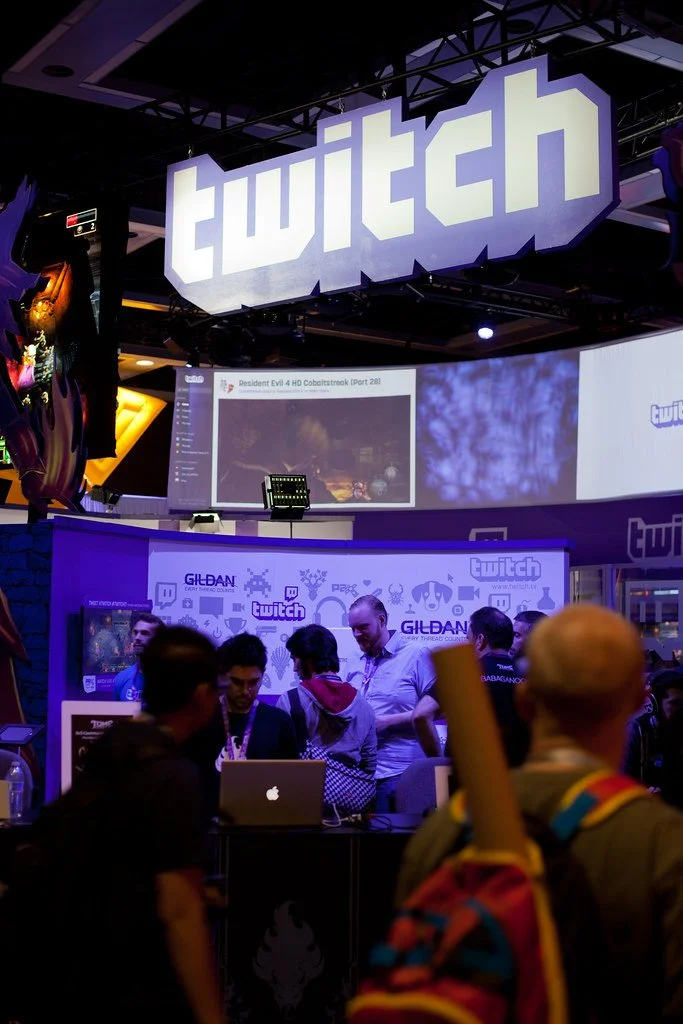The Attention Economy and Esports: An Econometric Analysis of Twitch Viewership
By Nicholas Watanabe, Hanhan Xue, Joshua I. Newman and Grace Yan
Watanabe and Yan are with the Department of Sport and Entertainment Management, University of South Carolina, Columbia, SC, USA. Xue and Newman are with the Department of Sport Management, Florida State University, Tallahassee, FL, USA.
Photo Credit: "PAX 2014 Twitch Booth" by camknows is licensed under CC BY-NC-SA 2.0. To view a copy of this license, visit https://wordpress.org/openverse/image/c6198e10-44ac-427a-a5f1-2ccd8f32fb40
This study seeks to develop a theoretical and empirical understanding of the nature of esports consumption, while relating these findings back into the realm of sport management. To do so, we draw upon the concept of the “attention economy” (Simon, 1984)—which operate`s with the understanding that due to increased connectivity and availability of information, it is the attention of consumers that becomes a scarce resource for which organizations must compete—to theorize the relations of media interconnectivity, digitality, and esports consumer behavior through esports live streaming. Moreover, attention economy behavior is also viewed as a proxy for individual demand for information products (Ciampaglia, Flammini, & Menczer, 2015). As such we propose a framework for investigating consumer demand in esports by analyzing the main economic factors that determine online viewing activity of esports content on the Twitch streaming platform.
This focuses on consumer preferences and quality of contest as the factors relevant to analyzing online esports viewership (attention). Specifically, data were collected from the TwitchTracker.com website during the time window from November 1st, 2016 to the last day of December of 2019. The measures were estimated using a generalized least squares regression with random effects and standard errors clustered by channels.
Our empirical findings provide important advances in terms of utilizing structural factors in modeling demand for sport in the digital realm, as well as enhancing the understanding of esports consumer behaviors. The model reveals that various structural factors have significant relationships with attention metrics that serve as proxies of demand. Notably, the structural factors range from the level of popularity that channels were able to accumulate on the platform, to the design and content of media provided to users. In this manner, future research focused on the demand for digital products should continue to build off the model presented in this study to further analyze how structuration and other factors may influence online consumer behaviors.
In addition, the findings from our models indicate an interest from esports viewers in competition, which connects both to findings from surveys of esports viewers (Pizzo et al., 2018), as well as the overall understanding of sport consumer behavior (McDonald & Rascher, 2000). As such, it can be understood that while the consumption of esports may differ from traditional sport in a number of aspects, there still are certain behavioral patterns that are rather analogous.
Furthermore, our results also emphasize that the very design of Twitch and the games themselves play a vital role in directing attention to certain channels broadcasting esports. That is, in considering the viewership of games, while many game types did not have accompanying increases in the number of views or viewers a channel received, they did experience greater lengths of views. Moreover, this also falls in line with the arguments presented by Qian, Zhang, Wang, and Hulland (2019), in that there is need to consider the unique aspects of esports and video games in examining the behavior of esports consumers. That is, the structure of esports streaming provides a greater participatory aspect, as well as other dimensions that are not normally considered within examinations of sport consumer behavior. As such, future studies of esports consumption should carefully consider the elements of both contexts so as to develop further insights into esports behaviors.
For managerial implications, our findings can help organizations understand the nature of the attention economy in digital environments, and consider ways to try to attract flows of attention. Furthermore, organizations need to recognize the difference between various types of microtransactions and the transactions typically found in traditional sport consumption. Lastly, managers should be aware that there is a mass of attention that is available online, but capturing it can be dependent on a variety of factors—some of which organizations may not be able to control.
References
Ciampaglia, G.L., Flammini, A., & Menczer, F. (2015). The production of information in the attention economy. Scientific Reports, 5(1), 9452. PubMed ID: 25989177 doi:10.1038/srep09452
McDonald, M.,&Rascher, D. (2000). Does bat day make cents? The effect of promotions on the demand for Major League Baseball. Journal of Sport Management, 14(1), 8–27. doi:10.1123/jsm.14.1.8
Pizzo, A.D., Na, S., Baker, B.J., Lee, M.A., Kim, D., & Funk, D.C. (2018). eSport vs. Sport: A Comparison of Spectator Motives. Sport Marketing Quarterly, 27(2), 108–123.
Qian, T.Y., Zhang, J.J., Wang, J.J., & Hulland, J. (2019). Beyond the game: Dimensions of esports online spectator demand. Communication & Sport, 8(6), 825–851. doi:10.1177/2167479519839436
Simon, H.A. (1984). On the behavioral and rational foundations of economic dynamics. Journal of Economic Behavior & Organization, 5(1), 35–55. doi:10.1016/0167-2681(84)90025-8

